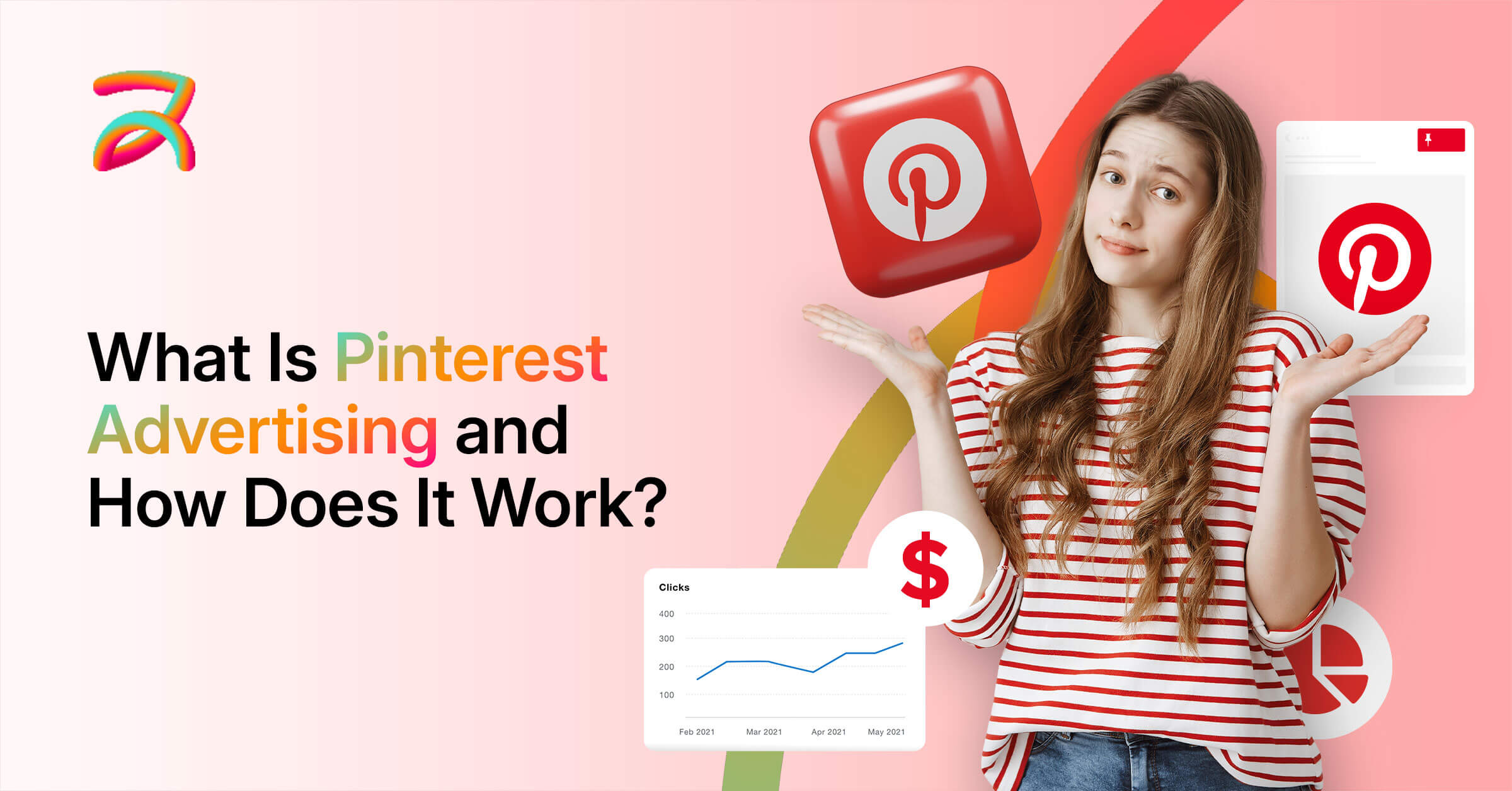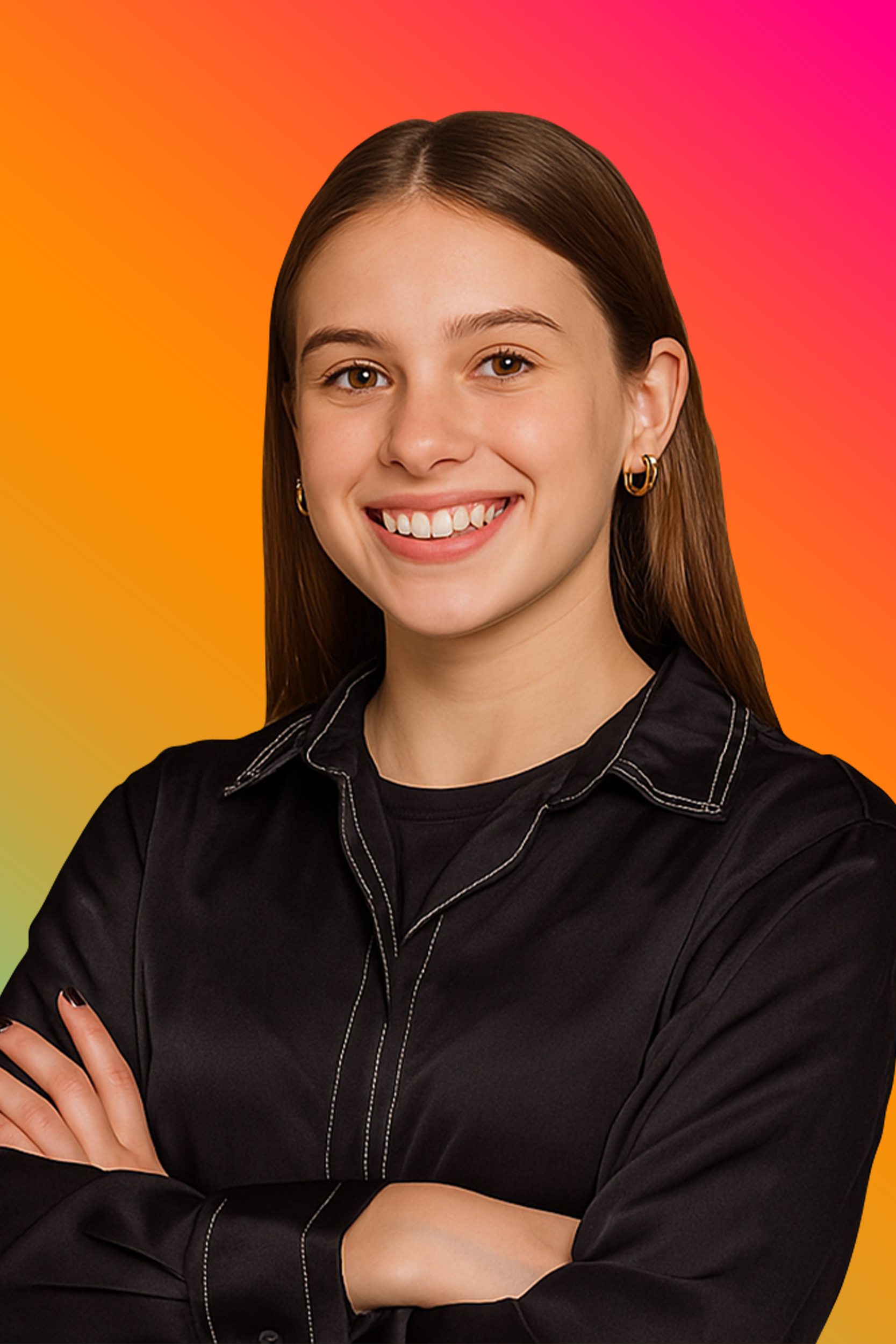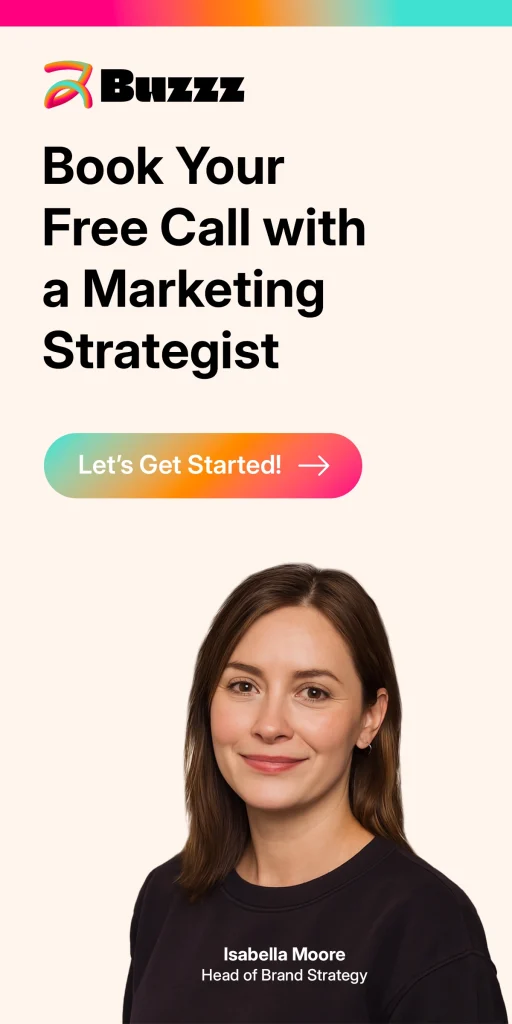Pinterest isn’t just a digital pinboard; it’s a visual search engine packed with high commercial intent. In 2025, Pinterest advertising continues to be a powerful tool for brands aiming to reach users in decision-making moments.
Over 498 million monthly active users browse Pinterest looking for inspiration, product ideas, and DIY tips (Pinterest, Q1 2025). That intent makes the platform an effective space for advertisers to connect with users ready to act.
In this guide, you’ll learn:
- What Pinterest advertising is
- How it works
- The different ad formats
- Costs and pricing models
- Targeting options
- Best practices and tools
- Future trends and strategies for success
Understanding Pinterest as an Advertising Platform
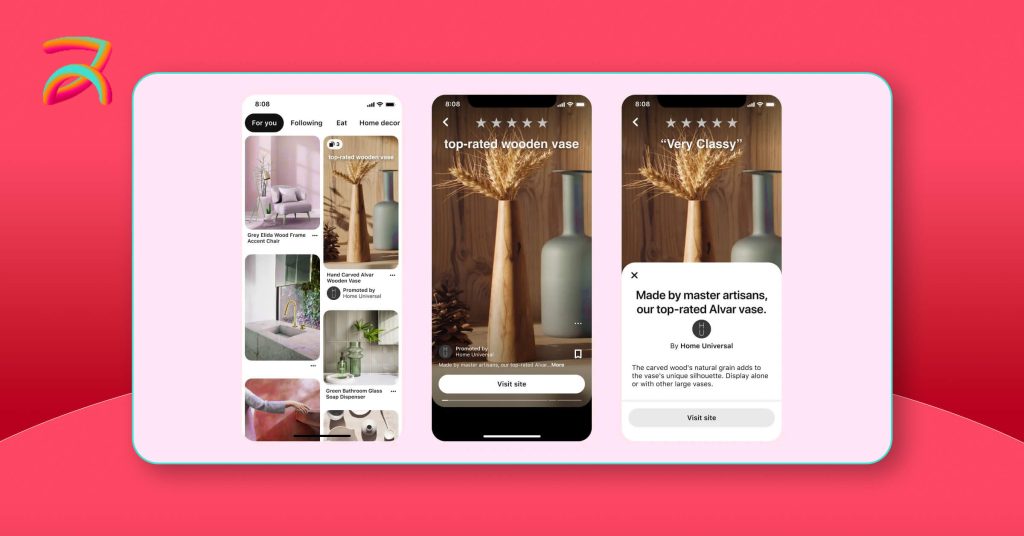
Pinterest stands apart from traditional social media platforms. It’s not where people go to catch up with friends or share personal updates. Instead, Pinterest functions as a visual discovery engine where users actively search for ideas, products, and solutions.
What Is Pinterest?
Pinterest is a visual discovery platform where users create boards to save and organize content called “Pins.” Think of it as a digital vision board meets search engine.
The Pinterest website and Pinterest app serve different but complementary purposes:
- Pinterest website: Full-featured experience perfect for detailed browsing and planning
- Pinterest app: Mobile-optimized for quick saves and on-the-go discovery
- Core functionality: Users “pin” images and videos to themed boards
- Search-driven: People use Pinterest to find specific solutions and ideas
Key differences from social media:
- Users plan for future purchases rather than share current experiences
- Content discovery happens through search, not social feeds
- The Pinterest icon represents inspiration and planning, not social connection
- Long-term content value versus ephemeral posts
Why Pinterest Is Different from Other Social Media Platforms
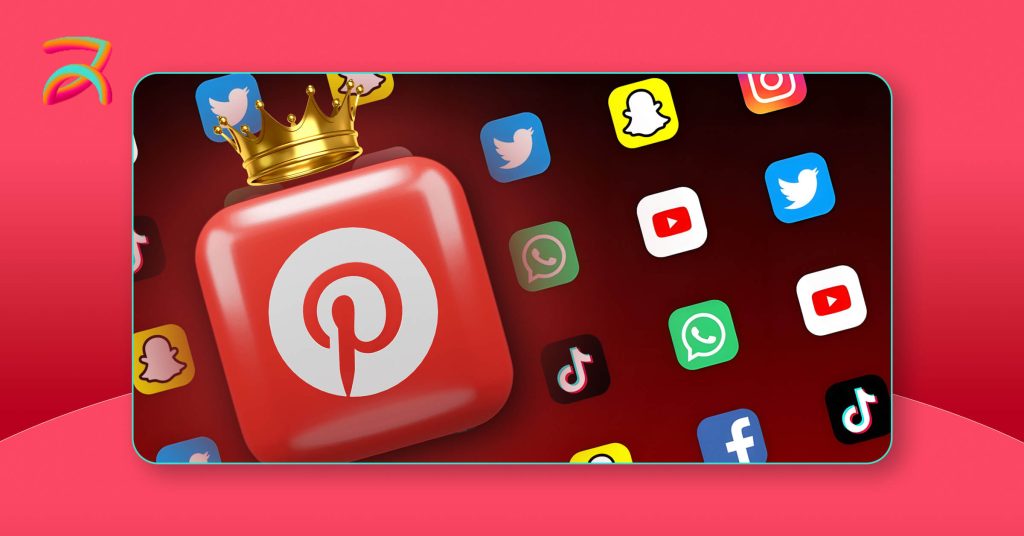
Pinterest users come with different intentions than Facebook or Instagram users. This fundamental difference makes Pinterest advertising incredibly powerful for the right businesses.
Visual-first discovery engine:
- Users actively search for solutions and inspiration
- High commercial intent drives better conversion rates
- Visual format perfect for product showcases
- Search functionality works like Google for visual content
Longer content lifespan benefits:
- Pins remain discoverable for months or years
- Evergreen content continues generating traffic
- No algorithm timeline decay like other platforms
- Compound ROI from a single piece of content
Shopping-focused user behavior:
- 85% of users have made purchases based on Pinterest content
- Users research and plan purchases on Pinterest
- Direct path from inspiration to purchase
- Higher average order values than other social platforms
Pinterest for Business: The Foundation
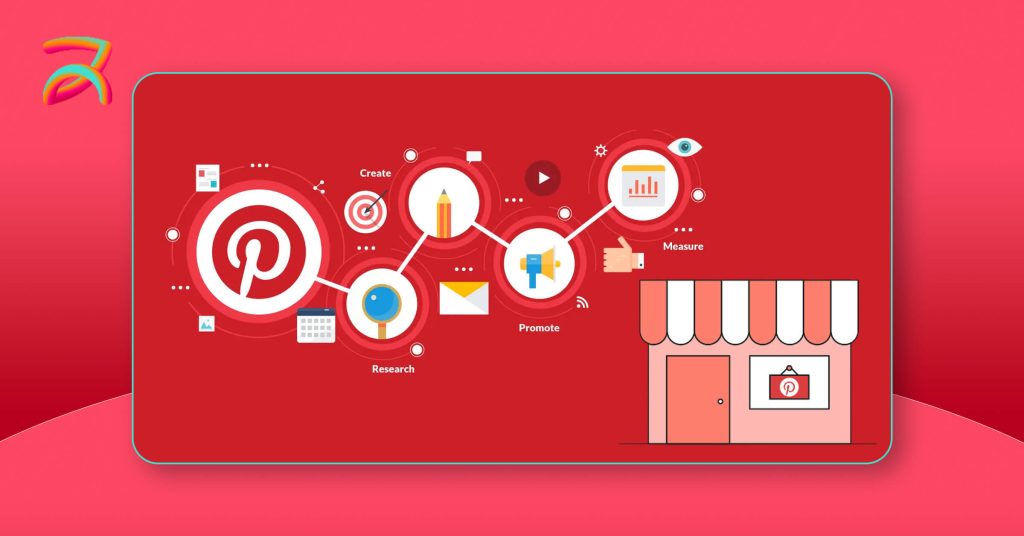
Converting to a Pinterest business account unlocks advertising capabilities and provides essential analytics. This upgrade costs nothing but delivers significant value.
Business account benefits:
- Access to Pinterest Ads Manager
- Detailed Pinterest analytics and audience insights
- Product catalog integration capabilities
- Verification badge for brand credibility
- Rich Pins with enhanced product information
Verification requirements:
- Website verification through HTML tag or file upload
- Consistent brand information across profiles
- Quality content that follows Pinterest guidelines
- A regular posting schedule demonstrates an active presence
Analytics access includes:
- Audience demographics and interests
- Top-performing content identification
- Traffic and conversion tracking
- Seasonal trend analysis for your niche
What Is Pinterest Advertising?
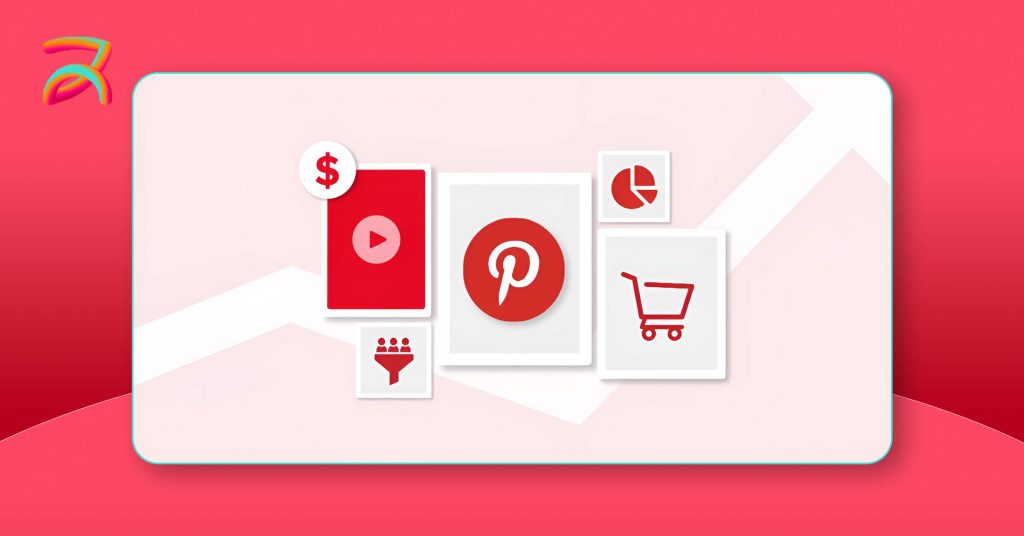
Pinterest advertising allows businesses to promote their content to targeted audiences through the platform’s visual discovery engine. Unlike traditional social media ads, Pinterest ads blend seamlessly into users’ search results and feeds.
Pinterest Ads Definition and Core Concepts
Pinterest ads are promoted pins that appear in users’ search results, home feeds, and related pins sections. These ads look and feel like organic content but reach specific audiences based on targeting parameters.
Core advertising concepts:
- Promoted Pins: Regular pins with paid amplification
- Auction system: Advertisers bid for placement in relevant searches
- Visual integration: Ads match Pinterest’s native content format
- Discovery-focused: Ads appear when users search for related topics
Integration with organic strategy:
- Promoted pins can boost organic content performance
- Successful organic pins make excellent ad creative
- Pinterest board strategy supports both organic and paid efforts
- Consistent visual branding across all content types
How Pinterest Advertising Works
Pinterest operates on an auction-based advertising system similar to Google Ads. Advertisers compete for placement in relevant user searches and feeds.
The Pinterest auction process:
- User performs a search or browses their feed
- Pinterest identifies relevant ads based on targeting
- Auction determines which ads appear based on bid and quality
- Winning ads display in search results or feeds
- Advertisers pay only when users take specified actions
Pinterest Ads Manager interface provides:
- Campaign creation and management tools
- Audience targeting and demographic selection
- Budget allocation and bidding controls
- Performance tracking and analytics
- Creative asset management and optimization
Campaign creation workflow:
- Set campaign objectives (awareness, traffic, conversions)
- Define target audience parameters
- Set budget and bidding strategy
- Upload and optimize creative assets
- Launch campaign and monitor performance
🚀 Want to See How Pinterest Can Grow Your Business?
Pinterest isn’t just about inspiration, it’s where buyers make decisions. Learn how to use Pinterest Ads to reach new audiences, increase brand visibility, and drive more sales.
Explore Pinterest Advertising TodayPinterest Advertising vs Organic Marketing
Smart Pinterest marketers combine both paid and organic strategies for maximum impact. Each approach serves different purposes in the customer journey.
How to post on Pinterest organically:
- Create valuable, high-quality visual content
- Optimize pins for Pinterest keywords and search
- Develop themed Pinterest boards for different topics
- Maintain a consistent posting schedule
- Engage with the community through repins and comments
Pinterest board strategy elements:
- Organized boards by topic or customer interest
- Mix of original content and curated pins
- Seasonal and trending topic incorporation
- Cross-promotion between related boards
When to use paid vs organic approaches:
- Organic: Building long-term brand presence and authority
- Paid: Accelerating growth and targeting specific audiences
- Combined: Promoting top organic performers with ads
- Testing: Using organic content to identify winning creative
Types of Pinterest Ads and Formats
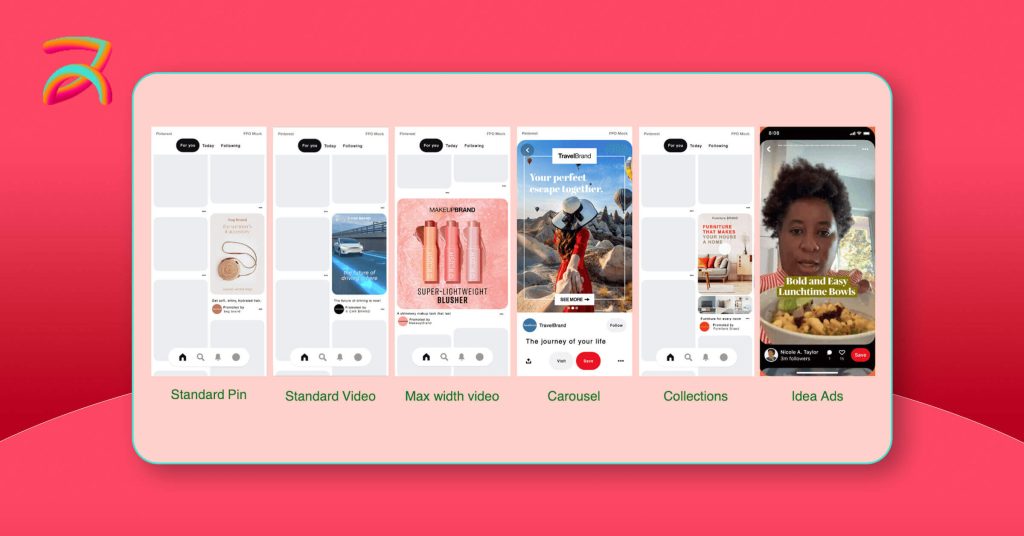
Pinterest offers multiple ad formats designed for different marketing objectives. Each format serves specific purposes and performs better for certain business types.
Standard Pin Ads
Standard pin ads represent the foundation of Pinterest advertising. These promoted pins appear in search results and feeds, looking identical to organic pins but reaching targeted audiences.
| Category | Details |
| Pin Characteristics | – Single image format – Text overlay support – Clickable to the site – Vertical (2:3) or square (1:1) |
| Best Practices | – Use high-quality vertical images (1000x1500px) – Add clear, readable text overlay – Optimize titles/descriptions with relevant Pinterest keywords – A/B test styles and CTAs |
| Performance Expectations | – Average CPC: $0.50–$1.50 per click – Lower cost vs Facebook/Instagram ads – Higher conversions due to high shopping intent – Longer content lifespan improves ROI |
Video Pin Ads
Video pins capture attention and showcase products in action. Pinterest trends show increasing video consumption, making this format increasingly valuable.
| Category | Details |
| Video Specifications | – Max Length: 15 minutes (Best: 15–30 sec) – Aspect Ratio: 2:3 (vertical) or 1:1 (square) – File Size: Up to 2GB – Formats: MP4, MOV, M4V |
| Creation & Optimization Tips | – Hook users in the first 3 seconds – Add captions for sound-off viewing – Use real-life settings or demos – End with a strong call-to-action |
| Performance Advantages | – Higher engagement vs static Pins – Better for storytelling and tutorials – Ideal for product showcases – Priority placement in user feeds |
Shopping Ads
Shopping ads connect Pinterest directly to your product catalog, allowing users to purchase without leaving the platform. This format works exceptionally well for e-commerce businesses.
| Category | Details |
| Product Catalog Integration | – Automatic sync of product data – Real-time updates on pricing & stock – Multi-product display in a single ad – Direct purchase flow from Pinterest |
| Affiliate Marketing Opportunities | – Tag products with affiliate links – Track commissions via Pinterest Analytics – Collaborate with Pinterest creators – Access to Verified Merchant Program |
| E-commerce Specific Benefits | – Streamlined path to purchase – Higher conversion rates than standard pins – Automated campaign optimization tools – Easy integration with Shopify, BigCommerce, WooCommerce |
Carousel Ads
Carousel ads showcase multiple products or tell stories through sequential images. This format works well for brands with diverse product lines or complex narratives.
| Category | Details |
| Multiple Image Showcase | – Up to 5 swipeable cards per ad – Each card links to a unique landing page – Interactive format drives higher engagement – Combine product, lifestyle, and how-to content |
| Use Cases & Applications | – Showcase product lines (e.g. fashion, beauty) – Explain steps in tutorials or routines – Highlight before/after results – Promote seasonal launches or collections |
| Creative Best Practices | – Keep visual design consistent across cards – Tell a connected story or theme – Use the first card as a visual hook – Add strong CTA to each card (e.g. “Shop Now”, “See More”) |
App Install Ads
App install ads drive mobile app downloads directly through Pinterest. This format works particularly well for lifestyle, shopping, and utility apps.
| Category | Details |
| App Promotion Features | – Direct download links to iOS and Android stores – Tracks app installs and attributions – Create audiences based on app activity – Build lookalikes from app user data |
| Mobile-Specific Targeting | – Target by device type (iOS, Android) – Filter by mobile carrier or connection type – Target based on app usage patterns – Add demographic and location filters |
| Conversion Tracking Setup | – Use Pinterest SDK for app install attribution – Connect with Mobile Measurement Partners (MMPs) – Track post-install events (sign-ups, purchases) – Optimize for lifetime user value (LTV) |
Pinterest Ads Manager: Your Control Center
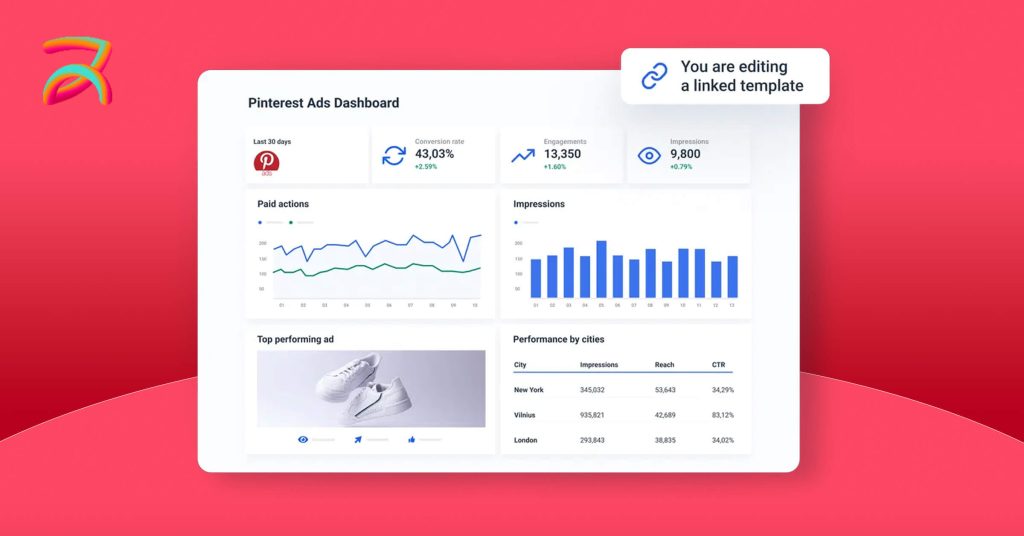
Pinterest Ads Manager serves as the central hub for all advertising activities. Understanding this interface maximizes campaign efficiency and performance tracking.
Navigating Pinterest Ads Manager Interface
The Pinterest ads manager dashboard provides comprehensive campaign management capabilities. The interface organizes information logically for efficient campaign oversight.
Dashboard overview sections:
- Campaign performance summary and key metrics
- Account-level budget and billing information
- Creative asset library and management tools
- Audience insights and demographic data
- Conversion tracking and attribution reports
Campaign organization structure:
- Campaigns: Top-level objective setting (awareness, traffic, conversions)
- Ad groups: Audience targeting and budget allocation
- Ads: Individual creative assets and messaging
- Keywords: Search term targeting for each ad group
Account setup requirements:
- Pinterest business account verification
- Payment method configuration
- Website domain verification
- Pinterest tag installation for tracking
Campaign Creation Process
Creating effective Pinterest campaigns requires strategic planning and proper structure. The campaign creation process guides advertisers through essential decisions.
Campaign objectives available:
- Brand awareness: Increase visibility and recognition
- Traffic: Drive visits to the website or landing pages
- App installs: Generate mobile app downloads
- Conversions: Optimize for purchases or leads
Ad group organization strategies:
- Group similar audiences together
- Separate testing initiatives into different ad groups
- Organize by product categories or customer segments
- Create seasonal or promotional-specific groupings
Targeting options and selection:
- Demographics: Age, gender, location, language
- Interests: Pinterest categories and topics
- Keywords: Search terms and related phrases
- Custom audiences: Website visitors, customer lists
Creative Asset Management
Organizing and optimizing creative assets streamlines campaign management and improves performance. Pinterest provides tools for efficient asset organization.
Image and video requirements:
- Dimensions: 1000 x 1500 pixels (vertical) recommended
- File size: Maximum 32MB for images, 2GB for videos
- Format: PNG, JPEG for images; MP4, MOV for videos
- Quality: High-resolution, clear, professional appearance
Pinterest design specifications:
- Vertical orientation performs best (2:3 aspect ratio)
- Text overlay should be legible and concise
- Brand logo placement for recognition
- Color schemes that stand out in feeds
Pinterest dark mode considerations:
- Test creative assets in both light and dark modes
- Ensure text remains readable in dark interface
- Consider color contrast for optimal visibility
- Design elements should work in both environments
Pinterest Advertising Costs and Pricing
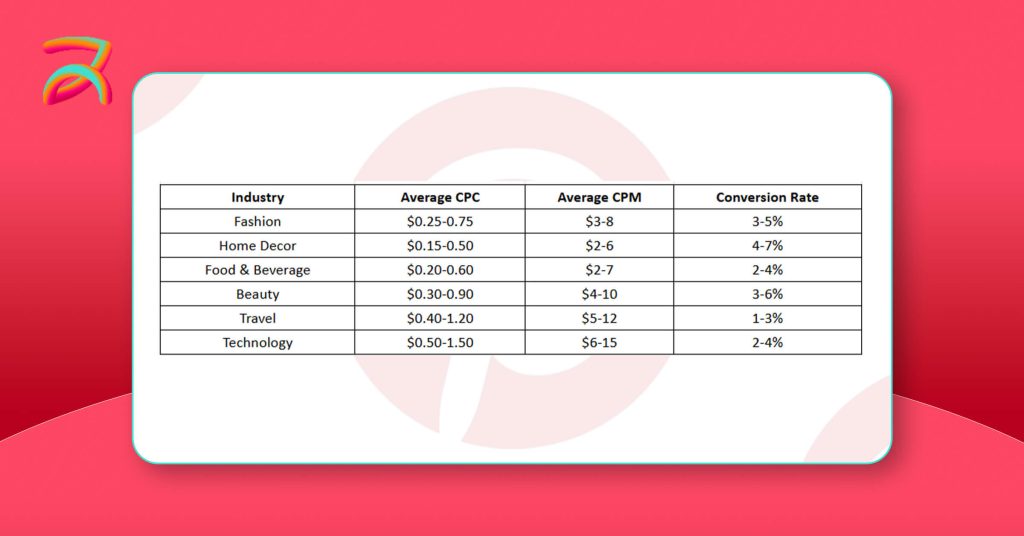
Understanding Pinterest advertising costs helps businesses budget effectively and maximize return on investment. Pinterest’s advertising revenue reached $4.20 billion in 2025, reflecting growing advertiser confidence in the platform.
How Much Do Pinterest Ads Cost?
Pinterest ads cost $0.00 – $0.10 per click, $0.00 – $2.00 per conversion, and $0.00 – $1.50 per 1000 impressions. However, actual costs vary significantly based on multiple factors.
Cost breakdown by business size:
| Business Size | Monthly Budget Range | Expected CPC | Expected CPM |
| Small Business | $200 – $1,000 | $0.10 – $0.50 | $1.00 – $3.00 |
| Medium Business | $1,000 – $5,000 | $0.20 – $0.80 | $2.00 – $5.00 |
| Enterprise | $5,000+ | $0.50 – $1.50 | $3.00 – $8.00 |
Industry benchmark comparisons:
- Fashion and beauty: Higher competition, $0.80 – $1.20 CPC
- Home and garden: Moderate competition, $0.40 – $0.80 CPC
- Food and recipes: Lower competition, $0.20 – $0.60 CPC
- Technology and business: Higher CPC, $1.00 – $2.00 range
Platform cost comparison:
- Pinterest CPCs average 50-70% lower than Facebook
- Better conversion rates offset slightly higher CPMs
- Longer content lifespan provides extended value
- Less competition results in more affordable placements
Pinterest Advertising Pricing Models
Pinterest offers multiple pricing models to match different campaign objectives and business needs. Understanding each model helps optimize budget allocation.
Cost-per-click (CPC) explained:
- Pay only when users click on ads
- Best for driving website traffic
- Budget control through maximum CPC bids
- Performance tracking through click-through rates
Cost-per-impression (CPM) benefits:
- Pay for ad visibility and brand exposure
- Effective for awareness campaigns
- Reach optimization over click generation
- Lower cost per thousand impressions
Cost-per-acquisition (CPA) bidding:
- Pay only for completed conversions
- Requires Pinterest tag implementation
- Automatic bid optimization for conversions
- Higher minimum budgets are required
Budget optimization strategies:
- Start with small daily budgets for testing
- Increase spending on high-performing ad groups
- Use lifetime budgets for time-sensitive campaigns
- Monitor cost per conversion closely
Factors Affecting Pinterest Ad Costs
Multiple variables influence Pinterest advertising costs. Understanding these factors helps optimize campaigns for better performance and lower costs.
Industry competition levels:
- High-demand seasons increase costs across industries
- Competitive niches drive up bid prices
- New product launches create temporary cost spikes
- Geographic competition varies by market maturity
Seasonal trends and pricing:
- Holiday seasons (November-December) see the highest costs
- Back-to-school (August-September) affects education/fashion
- Spring planning season (February-April) increases home/garden costs
- Summer months generally offer lower competition
Target audience factors:
- Narrow audiences cost more due to limited inventory
- High-income demographics command premium prices
- Popular interest categories have higher competition
- Geographic targeting affects costs significantly
Creative quality impact:
- High-quality creative assets reduce costs through better performance
- Relevant, engaging content improves quality scores
- A/B testing creative elements optimizes cost efficiency
- Fresh creative assets prevent ad fatigue
Pinterest Advertising Targeting Options
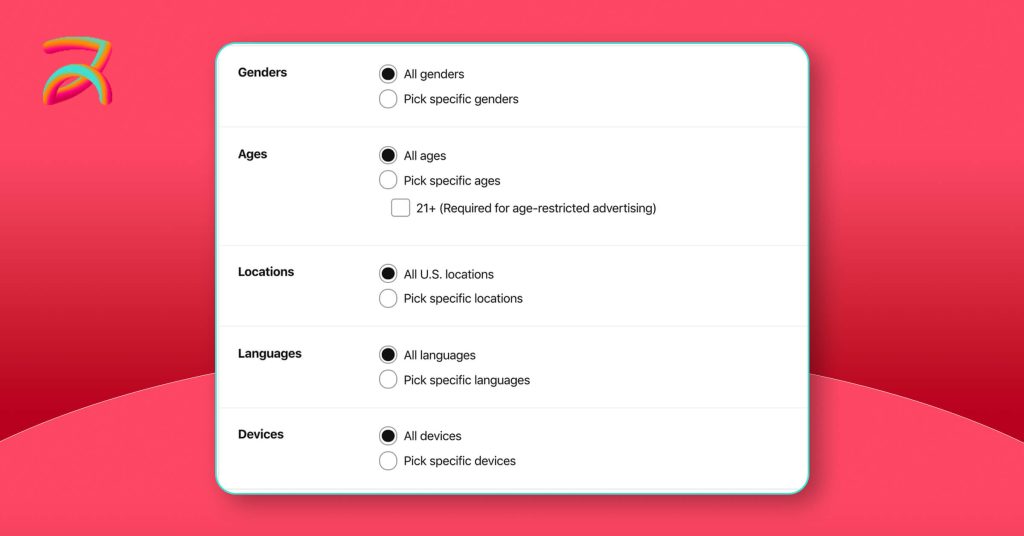
Pinterest’s targeting capabilities allow precise audience selection for maximum campaign effectiveness. The platform combines demographic, interest, and behavioral data for sophisticated targeting.
Audience Targeting Capabilities
Pinterest provides comprehensive audience targeting options that leverage user behavior and interests. These capabilities enable precise reach of ideal customers.
| Category | Details |
| Demographics & Interests | – Age groups: 13–17, 18–24, 25–34, 35–44, 45–54, 55–64, 65+ – Gender: All, Men, Women (Pinterest audience = ~60% female) – Location: Country, region, city, ZIP, radius – Language: 30+ supported languages |
| Pinterest Keyword Targeting | – Search-based: Ads appear based on user queries – Broad match: Includes keyword variations – Phrase match: Targets specific word combinations – Exact match: Shows ads for exact keywords only |
| Custom Audience Creation | – Website visitors: Retarget with Pinterest Tag – Customer lists: Upload emails or phone numbers – Engagement audiences: Target users who saved or clicked pins – Mobile app users: Reach users of your app |
| Lookalike Audience Development | – Build audiences similar to high-value users – Use source data from site visitors or CRM lists – Pinterest identifies users with similar interests – Ideal for scaling high-performing campaigns |
Interest and Keyword Targeting
Pinterest’s search-driven nature makes keyword targeting particularly effective. Users actively search for solutions, creating high-intent targeting opportunities.
Pinterest keyword research methodology:
- Use Pinterest search suggestions for keyword ideas
- Analyze top-performing organic pins for keyword inspiration
- Research competitor pins and their keyword strategies
- Monitor seasonal keyword trends and search volumes
Interest category selection:
- Level 1: Broad categories (Fashion, Home Decor, Food)
- Level 2: Specific subcategories (Wedding Fashion, Kitchen Design)
- Level 3: Niche interests (Boho Wedding Dresses, Modern Kitchen Islands)
- Combination targeting: Mix multiple interest levels
Negative keyword implementation:
- Exclude irrelevant search terms to improve targeting
- Prevent ads from showing for competitor brand names
- Filter out low-intent or bargain-hunting keywords
- Regularly review search terms and add negatives
Seasonal and trending topics:
- Identify trending Pinterest topics through the Pinterest Trends tool
- Plan campaigns around seasonal events and holidays
- Leverage cultural moments and viral content themes
- Monitor Pinterest seasonal insights for timing optimization
Behavioral and Demographic Targeting
Pinterest’s rich user data enables sophisticated behavioral targeting that reaches users based on actions and preferences rather than just interests.
Shopping behavior targeting:
- Engaged shoppers: Users who regularly click shopping pins
- Online shoppers: Active e-commerce participants
- Brand engagers: Users who interact with branded content
- High-intent users: Recent searchers for relevant topics
Device and platform preferences:
- Mobile vs desktop usage patterns
- iOS vs Android targeting for app installs
- Pinterest app vs mobile web users
- Connection type (WiFi vs cellular) targeting
Geographic and language targeting:
- Country-level targeting for international campaigns
- State and city targeting local businesses
- Postal code radius targeting for precise local reach
- Language preferences for multilingual markets
Life events and milestones:
- Wedding planning and engagement announcements
- New home purchases and moves
- New parent status and baby planning
- Back-to-school and graduation periods
Pinterest Marketing Strategy Integration
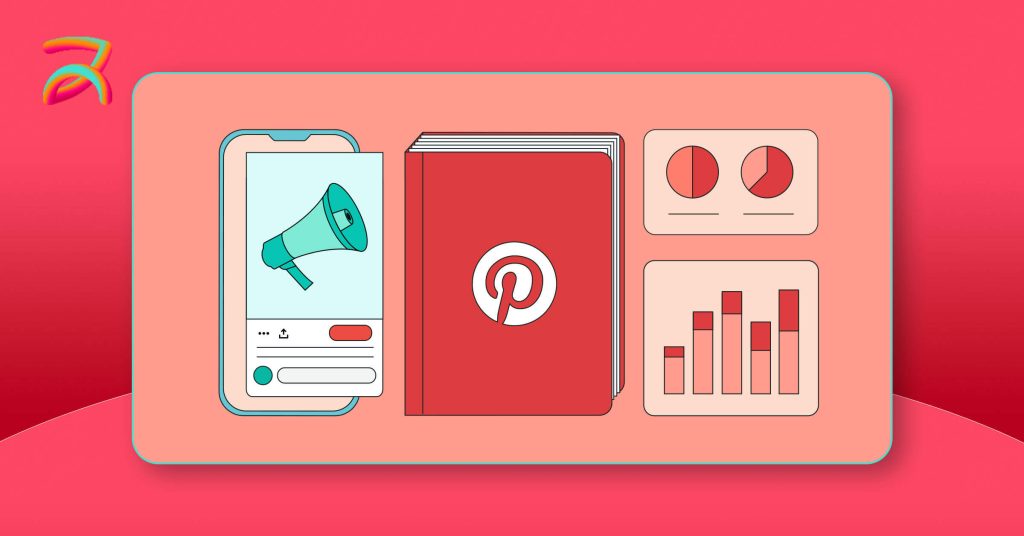
Successful Pinterest advertising works best when integrated with comprehensive Pinterest marketing strategies. This holistic approach maximizes both organic and paid performance.
Organic Pinterest Marketing Fundamentals
Building a strong organic presence provides the foundation for successful Pinterest advertising. Organic content often becomes the best-performing ad creative.
Pinterest marketing best practices:
- Create visually stunning, Pinterest-optimized images
- Write compelling pin descriptions with relevant keywords
- Develop comprehensive Pinterest board strategies
- Post consistently to maintain audience engagement
- Engage authentically with the Pinterest community
Content strategy development:
- Educational content: How-to guides and tutorials
- Inspirational content: Lifestyle and aspiration imagery
- Product showcases: Clear, appealing product photography
- Behind-the-scenes: Brand personality and authenticity
- User-generated content: Customer photos and testimonials
What is Pinterest used for across industries:
- E-commerce: Product discovery and shopping inspiration
- Food and recipes: Meal planning and cooking ideas
- Fashion and beauty: Style inspiration and trends
- Home and garden: Decorating and DIY projects
- Travel: Destination inspiration and trip planning
- Weddings: Planning and vendor discovery
Building brand presence organically:
- Claim your website and social media profiles
- Create branded Pinterest board covers
- Maintain consistent visual branding across all pins
- Develop thought leadership through valuable content
- Build relationships with other Pinterest creators
Keyword Research and Optimization
Pinterest functions as a visual search engine, making keyword research essential for both organic and paid success. Proper keyword optimization improves discoverability and campaign performance.
Pinterest keywords research methodology:
- Pinterest search suggestions: Type keywords and review autocomplete suggestions
- Pinterest Trends tool: Identify seasonal and trending search terms
- Competitor analysis: Review successful competitor pins and descriptions
- Google Keyword Planner: Research related terms and search volumes
- Pinterest Analytics: Analyze which keywords drive traffic to your pins
SEO principles for Pinterest:
- Include primary keywords in pin titles and descriptions
- Use natural language that matches how users search
- Incorporate long-tail keywords for specific topics
- Optimize Pinterest board titles and descriptions
- Add alt text to images for accessibility and SEO
Hashtag strategy and implementation:
- Use 3-5 relevant hashtags per pin (avoid overuse)
- Mix popular and niche hashtags for better reach
- Research hashtag popularity through Pinterest search
- Create branded hashtags for campaigns and events
- Monitor hashtag performance and adjust strategies
Pinterest trends identification:
- Monitor Pinterest Trends for seasonal opportunities
- Track Pinterest’s 100 annual trend report
- Follow the Pinterest official blog for platform updates
- Analyze Pinterest Predicts for future trend insights
- Use Pinterest audience insights for trend validation
Content Strategy for Pinterest Success
Developing compelling content that resonates with Pinterest users requires understanding platform-specific preferences and behaviors.
Pin design best practices:
- Vertical orientation: 2:3 aspect ratio performs best
- High-quality images: Minimum 1000 x 1500 pixels
- Clear, readable text: Legible fonts and color contrast
- Brand consistency: Logo placement and color schemes
- Mobile optimization: Designs work on small screens
Board organization and optimization:
- Create themed boards around customer interests
- Use keyword-rich board titles and descriptions
- Pin regularly to all boards (5-10 pins daily recommended)
- Mix original content with curated pins (80/20 ratio)
- Create seasonal boards for timely content
Seasonal content planning:
- Plan content 45-60 days ahead of season
- Create holiday-specific boards and content
- Leverage Pinterest seasonal insights data
- Develop a year-round content calendar
- Monitor competitor seasonal strategies
Pinterest trends analysis and application:
- Subscribe to Pinterest trend reports and insights
- Participate in trending hashtags when relevant
- Create content around emerging trends early
- Monitor the trend lifecycle for optimal timing
- Adapt trending concepts to your brand
Pros and Cons of Pinterest Advertising
Understanding Pinterest advertising advantages and limitations helps businesses make informed platform investment decisions.
Advantages of Pinterest Advertising
Pinterest offers unique benefits that make it an attractive advertising platform for many businesses, particularly those with visual products or services.
| Advantage | Description | Business Impact |
| High Purchase Intent | Users actively seek inspiration and products | Higher conversion rates than social media |
| Long Pin Lifespan | Content remains discoverable for months | Extended ROI period from campaigns |
| Visual Appeal | Image-focused platform ideal for brands | Better engagement and brand recall |
| Diverse Audience | Growing user base across demographics | Broader market reach opportunities |
| Shopping Integration | Native e-commerce features and catalogs | Streamlined purchase process |
| Cost-Effective | 2.3x lower cost per conversion vs other social platforms | Better budget efficiency |
| Less Competition | Fewer advertisers than Facebook/Instagram | Lower costs and better placement |
| Search-Driven | Functions like a visual search engine | Captures high-intent traffic |
Additional benefits include:
- Quality score system rewards relevant, engaging content
- Rich Pins provide enhanced product information
- Seasonal planning aligns with user behavior patterns
- Pinterest Analytics provides detailed audience insights
- Integration with major e-commerce platforms
Disadvantages and Limitations
Pinterest advertising also presents challenges that businesses should consider before investing significant resources in the platform.
Key limitations and challenges:
Smaller audience compared to major platforms:
- 340 million users vs Facebook’s 3+ billion
- Limited reach in certain demographics and regions
- Slower user growth compared to newer platforms
- Less global penetration than competitors
B2B marketing challenges:
- Platform skews toward consumer interests
- Limited professional networking features
- Fewer B2B-focused interest categories
- Longer sales cycles are difficult to track
Creative resource requirements:
- High-quality visual content is essential for success
- Constant need for fresh, trending creative
- Design skills or agency support are necessary
- Mobile optimization requirements
Platform learning curve:
- Different strategy from traditional social media
- Pinterest-specific optimization techniques are required
- Algorithm changes affect organic reach
- Analytics interpretation requires platform knowledge
Seasonal performance variations:
- Major fluctuations in costs and performance
- Q4 competition significantly increases costs
- Some industries see dramatic seasonal swings
- Budget planning is complicated by seasonality
Limited video advertising options:
- Fewer video formats than YouTube or TikTok
- Video production requirements are different than other platforms
- Less advanced video targeting options
- Limited video analytics compared to competitors
Pinterest Advertising Services and Support
Many businesses benefit from professional Pinterest advertising services, whether through agencies or Pinterest’s official support programs.
Pinterest Advertising Agency Benefits
Working with specialized Pinterest advertising agencies can accelerate results and improve campaign efficiency, particularly for businesses new to the platform.
| Category | Details |
| Agency Selection Criteria | – Pinterest expertise: Proven campaign success – Industry knowledge: Understands your market – Performance track record: Case studies, testimonials – Service scope: Full-service vs ad-only – Reporting: Transparent, detailed analytics |
| Services Offered | – Pinterest account setup and optimization – Ad strategy and planning – Creative asset production – Ongoing campaign management – Performance tracking and reporting – Pinterest SEO and organic strategy |
| When to Consider an Agency | – Limited in-house experience – Need for fast results and scale – Managing large product catalogs – Ad budget > $5,000/month – Internal focus needed elsewhere |
| Cost-Benefit Considerations | – Typical fees: 15–25% of ad spend – Assess performance lift vs cost – Factor in time and resource savings – Consider training vs outsourcing – Short-term vs long-term ROI analysis |
Pinterest Advertising Services Overview
Pinterest offers various support services and programs to help businesses succeed on the platform, from self-service tools to enterprise-level support.
Pinterest advertising services available:
- Pinterest Business Hub: Free resources and training materials
- Pinterest Academy: Certification courses and best practices
- Customer support: Email and chat support for advertisers
- Pinterest Partners: Verified agency and tool partnerships
Pinterest Partner Program benefits:
- Technology Partners: Third-party tools for campaign management
- Marketing Partners: Verified agencies with Pinterest expertise
- Content Partners: Creative and production service providers
- Analytics Partners: Advanced tracking and attribution tools
Training and certification options:
- Pinterest Business Certification program
- Webinar series on Pinterest advertising best practices
- Industry-specific training sessions
- Beta program access for new features
Support resources and documentation:
- Comprehensive Pinterest Business Help Center
- Video tutorials and step-by-step guides
- Community forums for advertiser discussions
- Regular updates on platform changes and features
Self-Service vs Professional Management
Deciding between managing Pinterest advertising internally or outsourcing requires careful consideration of resources, expertise, and business objectives.
Is Pinterest good for advertising assessment?
| Business Type | Self-Service Fit | Professional Management Fit |
| Small Business (<$1K/month) | High – Learn platform basics | Low – ROI may not justify |
| Medium Business ($1K-5K/month) | Medium – Depends on expertise | High – Accelerated learning |
| Enterprise (>$5K/month) | Low – Complex needs | High – Specialized expertise |
Resource requirements comparison:
- Self-service: 10-20 hours weekly for effective management
- Professional: 2-5 hours weekly for oversight and communication
- Learning investment: 3-6 months to develop proficiency
- Creative resources: Ongoing need for high-quality visual content
Skill development considerations:
- Pinterest platform-specific knowledge and best practices
- Creative design and visual marketing skills
- Data analysis and campaign optimization expertise
- Industry knowledge and competitive intelligence
- Project management and workflow organization
Performance expectations analysis:
- Self-service typically shows results in 60-90 days
- Professional management can accelerate to 30-60 days
- Learning curve affects early campaign performance
- Long-term success requires consistent optimization
📌 Ready to Get Expert Support for Your Pinterest Advertising?
From campaign setup to ongoing optimization, our team helps you run Pinterest Ads that attract the right audience, lower costs, and drive measurable growth. Get the guidance you need to make Pinterest a reliable sales channel.
Get My Pinterest Ads SupportSetting Up Your First Pinterest Ad Campaign
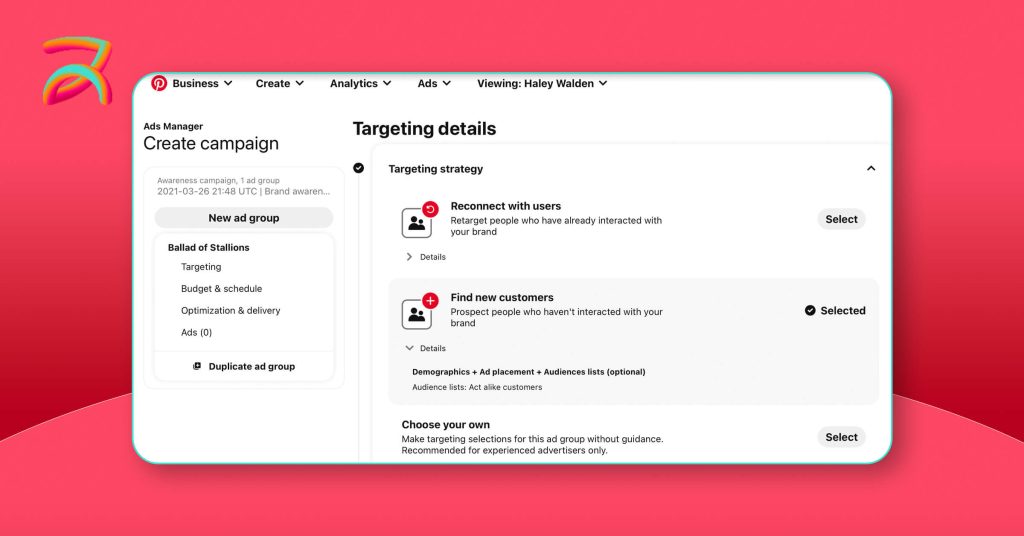
Creating your first Pinterest advertising campaign requires careful planning and strategic execution. This step-by-step approach maximizes your chances of success.
Pre-Campaign Planning
Proper planning prevents poor performance and wasted ad spend. Take time to establish clear objectives and understand your target audience before launching campaigns.
Goal setting and KPI definition:
- Awareness goals: Brand recognition, reach, impressions
- Traffic goals: Website visits, page views, bounce rate
- Conversion goals: Sales, leads, email signups, downloads
- Engagement goals: Saves, clicks, comments, shares
Target audience research methodology:
- Existing customer analysis: Demographics, interests, behaviors
- Pinterest audience insights: Platform-specific data analysis
- Competitor research: Analyze successful competitor campaigns
- Market research: Industry trends and consumer behavior patterns
- Persona development: Create detailed buyer personas
Competitive analysis approach:
- Identify top competitors on Pinterest
- Analyze their most successful pins and boards
- Review their Pinterest advertising strategies
- Identify gaps and opportunities in their approaches
- Monitor their seasonal campaign patterns
Budget allocation strategies:
- Start with the minimum recommended budgets ($1-5 daily)
- Allocate 70% to proven strategies, 30% to testing
- Plan for 3-month campaign cycles minimum
- Reserve budget for seasonal opportunities
- Factor in creative production costs
Campaign Setup Process
The technical setup process requires attention to detail and proper configuration for optimal performance and tracking.
Pinterest ads manager account creation:
- Business account verification: Confirm website ownership
- Payment method setup: Add a credit card or invoicing
- Billing information: Complete tax and business details
- Account permissions: Set up team access if needed
- API connections: Link relevant third-party tools
Pinterest pixel installation and tracking:
- Install the base Pinterest tag on all website pages
- Configure conversion events (purchases, signups, etc.)
- Test pixel firing and event tracking accuracy
- Set up an enhanced match for better attribution
- Implement custom conversions for specific goals
Campaign structure planning:
- Campaign level: Objective selection and budget setting
- Ad group level: Audience targeting and bid strategy
- Ad level: Creative assets and messaging
- Organization: Logical naming conventions for easy management
Creative asset preparation:
- Design vertical images (1000 x 1500 minimum)
- Create multiple variations for A/B testing
- Write compelling pin titles and descriptions
- Ensure brand consistency across all assets
- Optimize for mobile viewing experience
Launch and Initial Optimization
The first weeks of campaign performance provide crucial data for optimization decisions. Monitor closely and make data-driven adjustments.
Campaign monitoring best practices:
- Check performance daily for the first two weeks
- Monitor key metrics: impressions, clicks, conversions
- Review audience insights and demographics
- Analyze creative performance variations
- Track budget pacing and delivery
Early performance indicators:
- Delivery issues: Low impressions may indicate targeting problems
- High CPC: May suggest poor creative relevance or high competition
- Low CTR: Creative assets may need optimization
- No conversions: Check tracking setup and landing page experience
Quick optimization opportunities:
- Pause underperforming ad groups after 1000 impressions
- Increase budgets on high-performing campaigns
- Add negative keywords to improve targeting
- Test new creative variations weekly
- Adjust bidding strategies based on performance
Testing methodologies:
- Test one variable at a time for clear results
- Run tests for a minimum of 7 days or 1000 impressions
- Use statistical significance for decision-making
- Document test results for future reference
- Plan a testing calendar for systematic optimization
Pinterest Advertising Best Practices
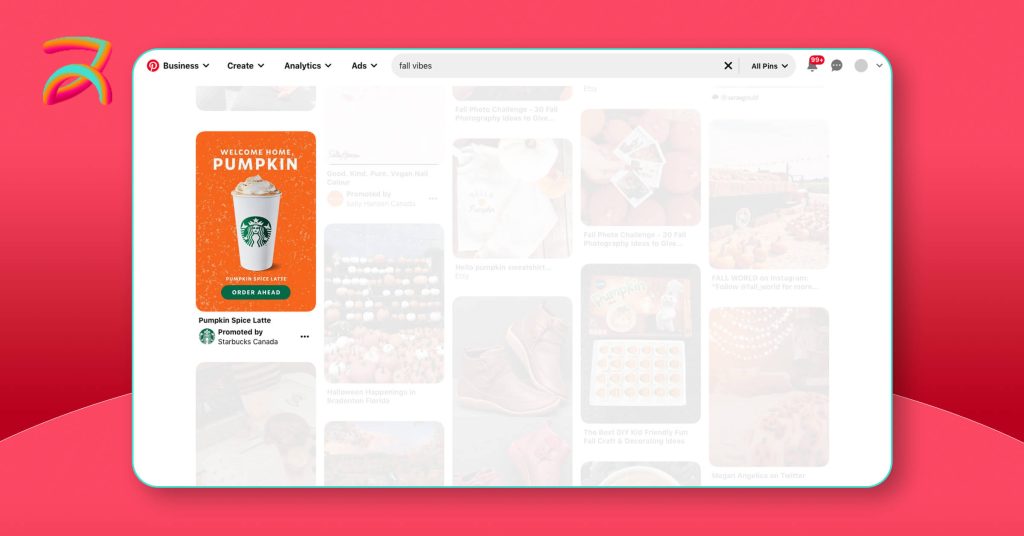
When it comes to Pinterest Ads, one of the proven tips to boost CTR & ROI is to follow platform-specific best practices that enhance campaign performance.
Creative Best Practices
Pinterest’s visual-first platform requires specific creative approaches that differ from other advertising platforms.
Pinterest-specific design principles:
- Vertical orientation: 2:3 aspect ratio performs 23% better
- High contrast: Ensure visibility in both light and dark modes
- Clear focal point: Single main subject draws attention
- Text overlay: Keep under 20% of image area
- Brand placement: Logo in the corner without overwhelming the design
Image quality and specifications:
- Minimum resolution: 1000 x 1500 pixels
- Maximum file size: 32MB for images
- Preferred formats: PNG for graphics, JPEG for photos
- Color space: sRGB for consistent display
- Text legibility: Minimum 14pt font size
Text overlay optimization:
- Use contrasting colors for readability
- Keep text concise and benefit-focused
- Include a clear call-to-action when appropriate
- Test text placement for mobile optimization
- Avoid covering important visual elements
Brand consistency maintenance:
- Develop Pinterest-specific brand guidelines
- Create templates for consistent design
- Use brand colors and fonts throughout
- Maintain voice and tone across descriptions
- Build recognition through consistent visual style
Targeting and Bidding Strategies
Effective targeting and bidding strategies maximize campaign efficiency and reduce costs while improving performance.
Audience testing methodologies:
- Broad testing: Start with a wide audience to gather data
- Narrow refinement: Gradually focus on best-performing segments
- Lookalike expansion: Scale successful audiences with lookalikes
- Custom combinations: Layer interests and behaviors strategically
- Exclusion testing: Remove low-performing audience segments
Bid optimization techniques:
- Start conservatively: Begin with lower bids and increase gradually
- Monitor competition: Adjust bids based on auction insights
- Dayparting: Increase bids during peak performance hours
- Device optimization: Adjust mobile vs desktop bidding
- Geographic adjustments: Bid higher in converting locations
Advertising on Pinterest scaling strategies:
- Horizontal scaling: Duplicate successful campaigns to new audiences
- Vertical scaling: Increase budgets on winning campaigns gradually
- Creative scaling: Expand successful creative concepts
- Keyword expansion: Add related keywords to successful campaigns
- Time-based scaling: Extend campaign duration for proven performers
Performance monitoring frameworks:
- Daily performance reviews for the first two weeks
- Weekly optimization sessions for ongoing campaigns
- Monthly strategic reviews and planning
- Quarterly campaign audits and restructuring
- Seasonal performance analysis and planning
Campaign Optimization Techniques
Continuous optimization drives long-term Pinterest advertising success through systematic testing and improvement.
A/B testing implementation:
- Creative testing: Images, headlines, descriptions
- Audience testing: Demographics, interests, behaviors
- Bidding testing: Manual vs automatic, different bid amounts
- Landing page testing: Different destinations for the same ads
- Timing testing: Schedule variations and dayparting
Performance analysis methods:
- Conversion funnel analysis: Track user journey from impression to conversion
- Attribution modeling: Understand multi-touch conversion paths
- Audience overlap analysis: Identify competing campaigns
- Creative fatigue monitoring: Track performance degradation over time
- Seasonal trend analysis: Compare year-over-year performance
Budget reallocation strategies:
- Move budget from low-performing to high-performing campaigns
- Increase investment in profitable audience segments
- Reduce spend on high-cost, low-return keywords
- Allocate seasonal budgets based on historical data
- Reserve emergency budget for trending opportunities
Seasonal adjustment practices:
- Plan campaigns 45-60 days ahead of major seasons
- Increase budgets during peak shopping periods
- Adjust creative assets for seasonal relevance
- Monitor competitor activity during high-traffic periods
- Prepare backup campaigns for unexpected trends
Measuring Pinterest Advertising Success
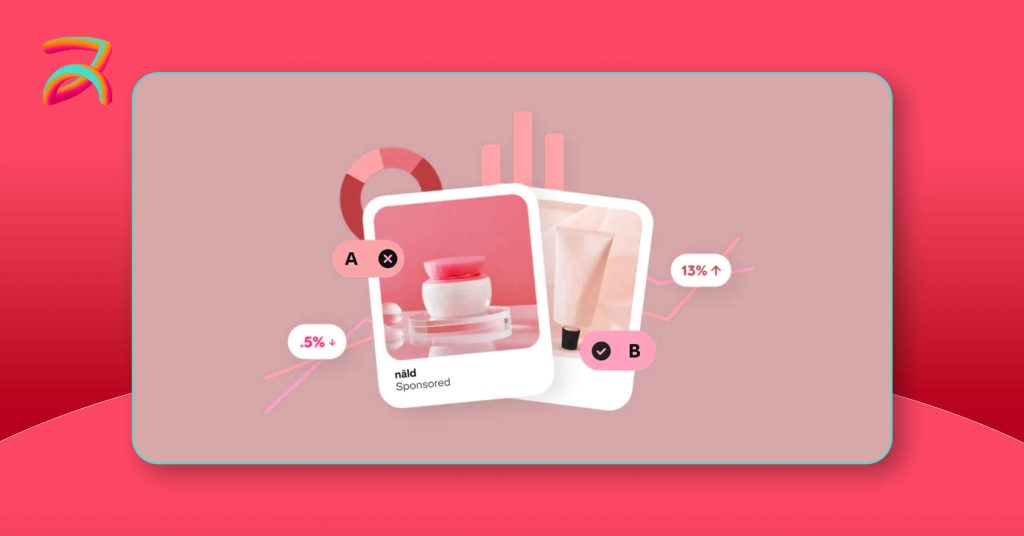
Accurate measurement and analysis drive informed decision-making and campaign optimization for sustained success.
Key Performance Indicators (KPIs)
Tracking the right metrics ensures campaign success measurement aligns with business objectives and provides actionable insights.
Essential metrics for Pinterest ads:
- Impression metrics: Reach, frequency, impression share
- Engagement metrics: Clicks, saves, comments, shares
- Traffic metrics: Website visits, page views, session duration
- Conversion metrics: Sales, leads, sign-ups, downloads
- Financial metrics: ROAS, CPA, lifetime value, profit margins
Conversion tracking setup requirements:
- Pinterest tag installation on all website pages
- Event configuration for specific actions
- Enhanced match setup for better attribution
- Custom conversion definition for business goals
- Cross-device tracking for the complete user journey
Attribution model considerations:
- First-click attribution: Credits initial Pinterest interaction
- Last-click attribution: Credits final click before conversion
- Multi-touch attribution: Distributes credit across touchpoints
- Time-decay attribution: Gives more credit to recent interactions
- Position-based attribution: Emphasizes first and last interactions
ROI calculation methods:
- ROAS formula: (Revenue from ads / Ad spend) × 100
- Net profit calculation: Revenue – (COGS + Ad spend)
- Customer lifetime value: Total customer value over the relationship
- Payback period: Time to recover customer acquisition cost
- Incremental lift: Additional sales attributed to Pinterest ads
Pinterest Analytics and Reporting
Pinterest provides comprehensive analytics tools for measuring organic and paid performance across the platform.
Native analytics platform features:
- Overview dashboard: High-level performance summary
- Audience insights: Demographics, interests, device usage
- Top pins analysis: Best-performing organic and paid content
- Website analytics: Traffic and conversion tracking
- Video analytics: Video-specific engagement metrics
Third-party tracking integration:
- Google Analytics: Enhanced e-commerce tracking setup
- Facebook Pixel: Cross-platform attribution and optimization
- Adobe Analytics: Enterprise-level tracking and analysis
- Marketing automation: Lead scoring and nurture integration
- CRM integration: Customer data platform connections
Custom reporting creation:
- Automated reports: Daily, weekly, monthly performance summaries
- Executive dashboards: High-level KPI tracking for stakeholders
- Campaign-specific reports: Detailed analysis for individual campaigns
- Competitive benchmarking: Performance comparison with industry standards
- ROI reporting: Financial impact and business value demonstration
Performance benchmarking standards:
- Compare performance against industry averages
- Track improvement over time with historical data
- Set realistic goals based on business maturity
- Monitor competitor performance when possible
- Adjust expectations for seasonal variations
Optimization Based on Data
Data-driven optimization transforms campaign performance through systematic analysis and strategic adjustments.
Data-driven decision-making process:
- Collect data: Gather performance metrics across all campaigns
- Analyze patterns: Identify trends and anomalies in performance
- Form hypotheses: Develop theories for performance variations
- Test solutions: Implement changes systematically
- Measure results: Track impact of optimization efforts
Performance trend analysis:
- Weekly trend monitoring: Identify short-term performance shifts
- Monthly performance reviews: Analyze longer-term patterns
- Seasonal comparison: Year-over-year performance analysis
- Competitive monitoring: Track market changes and competitor activity
- External factor correlation: Connect performance to market events
Campaign adjustment strategies:
- Budget optimization: Reallocate spend based on performance
- Targeting refinement: Narrow or expand audiences strategically
- Creative refreshing: Update assets showing performance decline
- Bidding adjustments: Optimize bids for cost efficiency
- Landing page optimization: Improve conversion rates
Scaling successful campaigns:
- Gradual budget increases: Scale winning campaigns carefully
- Audience expansion: Test lookalike and related audiences
- Geographic expansion: Extend successful campaigns to new markets
- Creative multiplication: Develop variations of winning creative
- Keyword expansion: Add related terms to successful campaigns
Pinterest Advertising Trends and Future
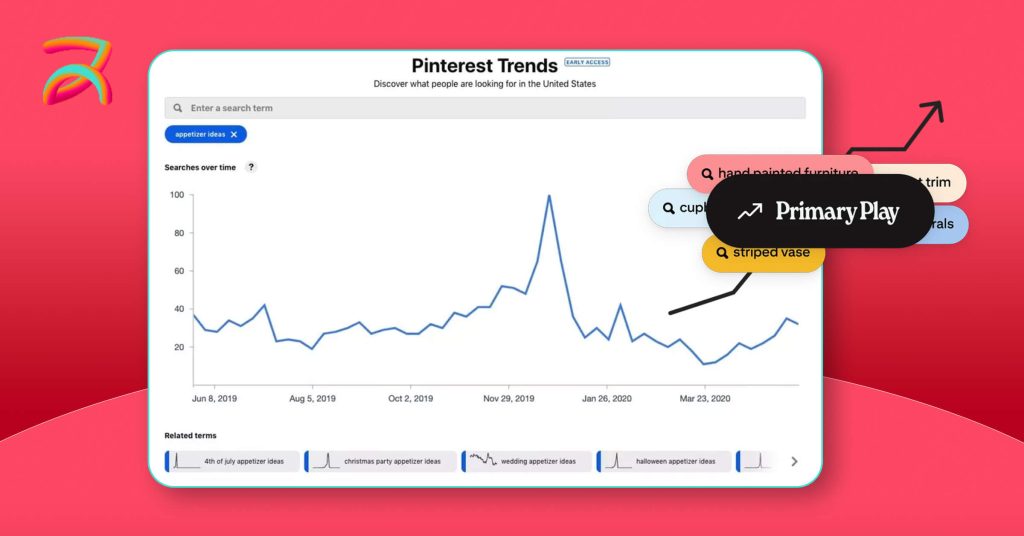
Understanding current trends and future developments helps businesses prepare for evolving Pinterest advertising opportunities.
Current Pinterest Advertising Trends
Pinterest continues evolving its advertising platform with new features and capabilities. Video content consumption increased 35% year-over-year, while shopping-related searches have increased by 138% over the last five years..
| Category | Details |
| Pinterest Trends in Advertising | – Video growth: Video Pins show higher engagement and completion rates – Shopping integration: Improved catalogs, pricing, and checkout features – Mobile-first focus: Prioritizing vertical formats and responsive design – AI optimization: Smarter bidding, targeting, and automation – Creator partnerships: Influencer collaboration for branded content |
| Emerging Ad Formats & Features | – Story Pins: Full-screen, swipeable content (multi-slide) – Idea Pins: Interactive, tutorial-like experiences with video and graphics – Product Rich Pins: Auto-updating with real-time price and stock info – Collection Ads: Curated shopping collections for lifestyle storytelling – AR Try-On: Augmented reality for beauty and fashion product demos |
| User Behavior Evolution | – Mobile usage continues to grow – Preference shift toward short-form video – More direct purchases via Pinterest itself – Seasonal content planning 2–3 months in advance – Users research across platforms before purchasing |
| Industry-Specific Trends | – E-commerce: Deeper Shopify, WooCommerce, and Magento integrations – Fashion/Beauty: AR try-ons, influencer-led styling guides – Food/Recipes: Video tutorials, ingredient-linked shopping – Home/Garden: DIY content and seasonal planning spikes – Travel: Visual destination discovery, itinerary pinning, booking integration |
Future of Pinterest Advertising
Pinterest’s roadmap focuses on commerce integration, AI optimization, and enhanced user experiences that benefit advertisers.
Platform development roadmap:
- Enhanced commerce: Deeper shopping cart and checkout integration
- AI improvements: Better audience targeting and creative optimization
- Cross-platform integration: Improved attribution across devices
- Creator tools: Enhanced partnership and collaboration features
- Analytics advancement: More sophisticated reporting and insights
Predicted feature releases:
- Advanced video advertising: More video format options and targeting
- Augmented reality expansion: AR features for more product categories
- Voice search optimization: Preparation for voice-activated shopping
- Subscription services: Premium features for business accounts
- International expansion: New markets and localized advertising options
Market position evolution:
- Continued growth as a visual discovery platform
- Increased competition with Instagram and TikTok
- Strengthening position in e-commerce and shopping
- Expansion into new demographic segments
- Enhanced integration with major retail platforms
Opportunities for advertisers:
- Early adoption advantages with new features
- Growing audience provides expanded reach
- Enhanced targeting capabilities improve efficiency
- Commerce integration streamlines the purchase process
- AI optimization reduces management complexity
Frequently Asked Questions (FAQs)
Common questions about Pinterest advertising help clarify platform capabilities and expectations.
Pinterest advertising allows businesses to promote visual content (called Pins) to users actively searching for ideas, products, or solutions. It works through an auction-based system inside Pinterest Ads Manager, where you create promoted Pins, define your target audience based on keywords, interests, and demographics, and bid for ad placements in user feeds and search results. Pinterest functions more like a visual search engine than a traditional social media platform, making it ideal for visually driven brands and products.
In 2025, Pinterest ads cost between $0.10 to $1.50 per click and $1.00 to $8.00 per 1,000 impressions, depending on your targeting, competition, and ad quality. For example, traffic campaigns average around $0.20–$0.80 CPC, while shopping ads typically range from $0.30–$1.20 CPC. Pinterest’s lower competition and high shopping intent help brands achieve lower cost-per-conversion compared to Facebook and Google, making it a strong option for businesses with budgets starting around $200–$500 per month.
Yes, Pinterest is especially effective for small businesses with visual products or services. The platform’s lower ad costs, longer content lifespan, and high-intent user base make it well-suited for niche targeting and sustained returns. Industries like fashion, home décor, beauty, food, and lifestyle perform best, particularly when using Pinterest Shopping features and strong visual creatives.
Pinterest offers five main ad formats: Standard Pins (single image ads), Video Pins (short-form video), Shopping Ads (linked product catalogs), Carousel Ads (multiple swipeable images), and App Install Ads (promoting mobile apps). Each format serves different marketing goals—from awareness to conversion—and appears in search results and user feeds based on targeting and bid performance.
Most advertisers start seeing results from Pinterest ads within 7 to 14 days. However, full optimization typically occurs over 30 to 60 days as Pinterest’s algorithm tests creatives and refines targeting. During the first week, performance data begins to accumulate. By the second and third weeks, trends become visible. After one to two months, well-optimized campaigns can be scaled for better long-term results.
No, Pinterest advertising requires a Pinterest business account. This account provides access to Ads Manager, Pinterest Analytics, audience insights, conversion tracking via the Pinterest Tag, and other essential advertising features. Setup is free and includes verifying your website and completing a business profile, which unlocks tools like product catalogs and rich pins.
Pinterest offers targeting options based on demographics, interests, keywords, and custom audience data. You can refine by age, gender, location, and language. Interest targeting matches users to broad categories like beauty, food, or home décor, while keyword targeting connects your ads to user searches. You can also build audiences using your site traffic, customer email lists, or mobile app data, and expand reach using lookalike audiences.
Pinterest advertising provides lower cost-per-click, longer content lifespan, and higher shopping intent compared to Facebook and Google. Pinterest users are often in the planning and discovery stage, which means they’re actively saving ideas and making purchase decisions. Unlike Facebook, where content is short-lived and engagement-focused, Pinterest pins can drive traffic for weeks or even months. Google targets search intent directly, but often with higher CPCs and more competition.
The most effective Pinterest strategy for eCommerce involves integrating product catalogs with Pinterest Shopping Ads, optimizing your pins for search with keywords and hashtags, and planning seasonal content 1 to 2 months in advance. Using lifestyle imagery and rich pins helps increase conversion rates by showing products in context. Pinterest users frequently research purchases early, making the platform ideal for seasonal and high-consideration products.
Top Pinterest advertising practices in 2025 include using vertical images with a 2:3 aspect ratio, incorporating short-form video pins, and designing mobile-first creatives. Most users browse Pinterest via the app, so clear visuals, readable text overlays, and strong calls-to-action perform best. Marketers should also align campaigns with seasonal trends, use Pinterest Predicts for insight, and track performance across devices using UTM parameters and conversion tracking.
Conclusion
Pinterest advertising isn’t just another paid media channel it’s a powerful visual discovery engine where users come with intent to explore, plan, and purchase. With its lower cost per conversion, high engagement, and unique search-driven behavior, Pinterest helps brands reach customers at the moment they are actively searching for ideas and inspiration..
By combining eye-catching creatives, strategic seasonal planning, and consistent optimization, businesses can turn Pinterest into a sustainable growth channel. Whether you’re looking to drive traffic, increase brand awareness, or generate sales, Pinterest Ads offer a proven way to connect with motivated audiences who are ready to act.
If you’re ready to unlock the full potential of Pinterest marketing, now is the time to build campaigns that inspire, engage, and convert.


